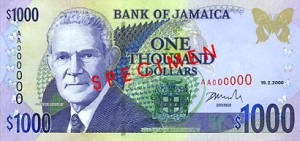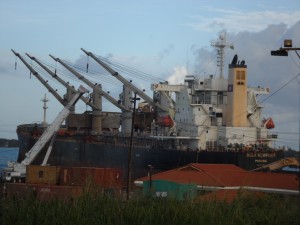Repo rate hiked
 Repo rates moved up by 25 basis points to 4 ½ percent in Trinidad & Tobago. At its September 2015 meeting, the Central Bank’s Monetary Policy Committee (MPC) agreed to increase the ‘Repo’ rate for a seventh consecutive time to 4.5 percent.
Repo rates moved up by 25 basis points to 4 ½ percent in Trinidad & Tobago. At its September 2015 meeting, the Central Bank’s Monetary Policy Committee (MPC) agreed to increase the ‘Repo’ rate for a seventh consecutive time to 4.5 percent.
According to the central bank, the most influential factor behind the MPC’s decision remains the normalization of US monetary policy which could reduce capital flows to many emerging market economies, including Trinidad and Tobago, which is already adjusting to persistently low energy prices. The MPC also judged the domestic monetary policy stance as still very accommodative in the context of a contracting non-energy sector and moderate inflationary pressures.
The central bank last increased repo rates in July by 25 basis points to 4.25 percent, then the bankers stated apart from similar reasons as above that locally, rising inflationary pressures remain a concern for the MPC. Headline inflation held steady at just over 5 ½ percent in June 2015, while core inflation slowed marginally to just below 2 percent. However, the MPC expects inflationary pressures to pick up in the remaining months of 2015 due to a number of factors.
The central bankers stated that domestic inflationary pressures have not materialized as initially expected. On a year-on-year basis to August 2015, headline inflation slowed to 4 percent from just over 5 ½ percent in July 2015. Core inflation was stable at just over 1 ½ percent, while food inflation decelerated to around 8 percent from double-digit territory of 11 ½ percent in July 2015. Although current price pressures seem contained, disruptions to domestic agricultural supply and higher production costs facing select food industries could lead to rising food inflation. Increased consumer spending driven in part by recently concluded public sector wage agreements, as well as robust consumer borrowing, could also push up inflationary pressures.
Food prices push inflation in August
‘Food and Non-Alcoholic Beverages’ recorded the highest movement for the month of 2.1 percent. ‘Vegetables and Starchy Foods’ had the strongest impact on the division moving up by 8.5 percent as drought conditions persisted in the growing areas. The upward overall movement was, however, tempered by declines of 2.3 percent and 0.5 percent in the divisions ‘Housing, Water, Electricity, Gas and Other Fuels’ and ‘Transport’ due to lower petrol prices and reduction in air fares.
Other divisions that recorded increases are: ‘Alcoholic Beverages and Tobacco’ 0.2 percent, ‘Clothing and Footwear’ 0.3 percent, ‘Furnishings, Household Equipment and Routine Household Maintenance’ 0.2 percent, ‘Health’ 0.1 percent, ‘Recreation and Culture’ 0.4 percent, ‘Miscellaneous Goods and Services’ 1.3 percent, while ‘Restaurants and Accommodation Services’ recorded a 0.2 percent increase. ‘Education’ and ‘Communication’ remained unchanged.
21% fall in Treasury bill rates in a year
Treasury bill rates are continue to decline with the latest ones falling ones continuing the trend once more. Rates are down 20.6 percent on the 182 days Treasury bill notes since September last year or 165 basis points.
Rates on the latest issues of Treasury bill that were on offer on Wednesday September 16th, continued a slow decent since the start of 2015 but a much steeper decline form March last year.  The two offerings for $400m each attracted bids for $721.8 million for the 91 days instrument and $786 million for the 182 days instrument, down from over $940 million each in August.
The two offerings for $400m each attracted bids for $721.8 million for the 91 days instrument and $786 million for the 182 days instrument, down from over $940 million each in August.
The 91 days instrument cleared at an average of 6.2 percent down from 6.352 percent at the August auction, with bids between 5.99 percent, to 6.3 percent being fully accepted. The 182 days yielded an average 6.35 percent down from August’s average of 6.49 percent. Bids between 6.2 to 6.4 percent, were fully allotted. Earlier, at the September 9th auction, the 28 days Treasury bill average rate came out at 6.228 percent after $707 million chased $400 million on offer.
The declines for the September issues come against the back ground of Bank of Jamaica cutting by 0.25 percent, its 30 days CD rates in August to 5.25 percent.
Remittance inflows flat in May
 Total remittance inflows for Jamaica for May this year was just barely up over May 2014, increasing by less than a million dollars to end the month at US$190 million over the corresponding month last year.
Total remittance inflows for Jamaica for May this year was just barely up over May 2014, increasing by less than a million dollars to end the month at US$190 million over the corresponding month last year.
Net remittance flows did better, with US$175 million realized, an increase of US$4 million or 2 percent over the corresponding period of 2014. For the first five months of 2015, total remittance inflows amounted to US$905 million, an increase of US$18 million or 2 percent over the similar 2014 period. Net remittances for the first 5 months of the year were US$812 million, an increase of US$16 million or 2 percent over the 2014 period, Bank of Jamaica reported.














